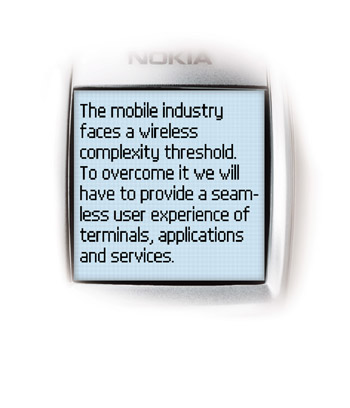Strive for a Seamless User Experience
|
|

The world is moving toward universal connectivity. . . . X gives you a new kind of freedom and convenient connection without . . . requirements. X and . . . are designed for people who desire freedom and flexibility in data communication.
Acknowledgment: www.nokia.com.
Less Complexity a Must for X to Add Value
Twenty-four respondents had been using X intensively for 4 weeks by June 2001, when they were interviewed in depth about their experiences with the product.
Recommendations
Apart from solving problems with reliability, the following improvements are needed to make X valuable to the business user:
-
One-click connection between phone and . . . X adds a layer of hassle and complexity which made many respondents prefer to go back to using . . . [present solution] rather than X. Managing multiple X . . . should be offered as an option only to very advanced users. The X software should be invisible to the average user.
-
PC X should mirror the phone UI. Many respondents discovered a whole new side of their phone when having used X . . . In particular . . . suddenly became a highly valuable function on the 6210 . . . However, PC X should more closely mirror the phone; its UI should behave like a phone UI to avoid learning barriers, and the functionality of the PC X should correspond more closely to all the things that you can do on the phone.
-
Avoid repeating the 'WAP is crap' problem. Less knowledgeable business users had expectations that X would cure all ills: that it would give faster connections to the Internet, that it would allow them to. . . . Expectations need to be managed, and the technology is better marketed on its specific application benefits than on the general X name.
Respondents in this research were mostly advanced mobile data users, but they nevertheless had problems using X and getting value from the product. Since X is a pioneering product, they were forgiving about its flaws. However, they were expecting a more mature product from the company they trust to deliver easy-to-use solutions.
Mobile phones continue a tradition of easy-to-use household products. A telephone is a known quantity; everybody understands its purpose and its basic operation. The first step toward mobile technologies consisted of nothing more than removing the wire. Now, content, applications, and services are exploding. Digital convergence, connectivity, mobile services, downloadable applications, mobile multimedia, location-based services, SyncML, Bluetooth, Wireless Village, and other mobile technology buzzwords lead to complex products and complicated applications. Good usability will become more difficult to provide. Design flaws will occur. The discipline is facing a wireless complexity threshold resulting from user interface density, off-line configurations, and usability incompatibility.
User interfaces for the second generation of communication products, namely, GSM terminals, were designed based on a set of functions that were considered sufficient and mature for implementation in the mid-1990s. Now the same user interfaces are being stretched thin with new features. If the UI solutions are flexible enough, these novelties can be realized in a manner that is reasonably usable as long as we look at each one in isolation. However, the amount of new features in itself adds additional layers to the user interface. There will be new menus, new settings, and longer lists of options. The right ones will be increasingly difficult to find. The overall complexity increases, and the old interfaces grow dense.
Many of the new systems therefore aim at automated services and a seamless user experience. In basic use, once all knobs and dials are set where they're supposed to be, there should be no problems. But then there is the matter of configuring services. The services-and their usage scenarios-are unknown to the phone manufacturers, who naturally find it difficult to define the appropriate system behavior. Thus they prefer to leave the decision to the end user. A priori offline settings are typically more difficult for the user to manage than real-time control, where the response from the system is immediately perceptible.
The mobile terminals, applications, services, and sometimes even service content originate from different sources. They may be technically compatible, but technical compatibility is different from 'usability compatibility.' A wireless service may be optimized for a terminal-or technology-completely different from yours. You'll need to reconfigure the device to get connection, and perhaps you'll even have to reverse the new configuration when you go back to the normal-usage modes. By contrast, features that are embedded in the product can be presented in an intuitive manner in the user interface. The user needs only to browse through the menus and check the available options. When a service depends on the cooperation of several devices and multiple communication technologies, all the options cannot be presented to the user. Often the user needs to know in advance what to look for-and where to look for it.
The wireless complexity threshold is impervious to any amount of usability work that is focused on services, applications, or terminals alone. We need to focus on producing seamless user experiences, where all the different layers of technology and service provisioning are streamlined to create end-user comfort and value.
|
|
EAN: 2147483647
Pages: 142